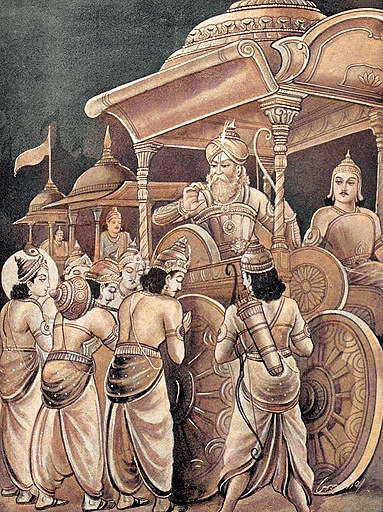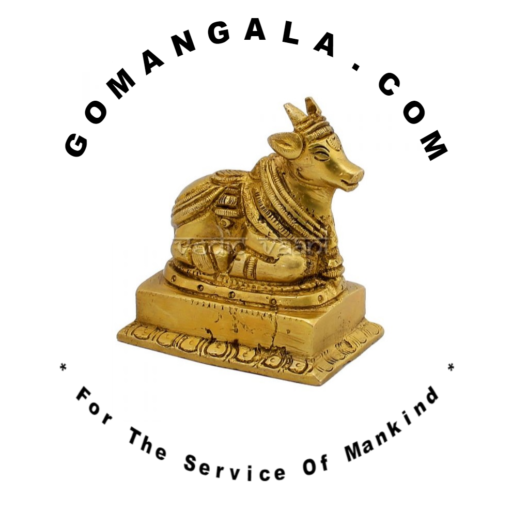Rathatiratha-Sankhya Parva is the fifty ninth Upa parva included in the fifth Maha parva named as Udyoga parva. Vaishampayana continued narration to Janamejaya in reply to his queries as follows.
Immediately after the return of Uluka, Yudhishtira had opined with Drishtadyuma to be the Senapathi, means the commander for his leading active army. Drishtadyumna was given army camping order at his choice. Yudhishtira had announced Drona as his enemy target and had suggested to his other six commanders the various other enemy war targets. During the war, surrendering of enemies was the main aim but self-defense was inevitable. Killing was not desired from the side of Yudhishtira. Everybody on the side of Yudhishtira would follow war time rules. Each commanders would blow the conch to start or stop the war.
Why Yudhishtira allotted the seven commanders in chief with enemy targets?
The seven commanders on the side of Yudhishtira were assigned enemy targets on the co-option methods. Drishtadyuma had already got Drona as the opposite target of the war suggested by Yudhishtira. This process is called as Senapati Niyoga before starting the war. Shikhandi was assigned Bhishma. Sahadeva got Shakuni. The five Upapandavas, means the five sons of Draupadi were kept in the reserve against the five Trigarta Princes. Chekitana was against Shala. Shaibhya got Kritavarma. Arjuna got Karna. Bhima got Duryodhana. Abhimanyu was kept in reserve but arranged against Vrishasena and other strong kings since he was more able than his father Arjuna. These were flexible assignments; in the field, each and every fighting soldier has to face any kind of enemies who came in his front row. Drishtadyumna was free to lead in the war taking his own war-time decisions.

What information from Bhishma was desired by Duryodhana?
Duryodhana had already assigned Bhishma as the commander-in-chief for his army troops. Hence he desired to know from his open mouth and loud voice about the capabilities of his side, details of leading and succeeding soldiers. The army ranks were referred as Atirathas, Rathas and Ardha Rathas.
As per Bhishma, who were Athirathas?
As per Bhishma, he himself was Atiratha. Drona, Shalya, Virata, Bhagadatta and Jayadratha were some of the strong kings referred as Atirathas.
As per Bhishma, who were Rathas?
All the Kaurava brothers, being in hundred, were Rathas. Also the sons of Duryodhana, Dushasana and Karna were Rathas. Almost all kings in his side were Rathas as referred by Bhishma.
Who were the sons of Duryodhana and Dushasana?
Lakshmana was the son of Duryodhana and Drumasena was the son of Dushasana. They were ranked as Eka Rathas and compared with the then king of Kosala kingdom of the name Brihadbala.
How Ashwathama was described by Bhishma?
Bhishma told Duryodhana about Ashwathama as an able soldier but not suitable for the battlefield due to his love for his physical body. He could not be considered for any army ranks in this warrant assignments.
How Karna was criticised and what Karna had told in reply?
Karna was not trustworthy according to Bhishma. Even though he was assigned the kingship of Anga kingdom, he never deserved any army ranks. This criticism of Bhishma had hurt the ego of Karna. Karna immediately had taken a vow and declared he would not be fighting in the army so far as Bhishma was active in the war field. He would be working as an external security for Hastinavati palace.
How Bhishma explained about Pandavas to Duryodhana?
Bhishma explained to Duryodhana about the sincerities of Pandavas towards Yudhishtira. Drona was pleased with Arjuna and he would not be killing him. Bhishma would be following the war time principles strictly adhering to the laws in force. He also assured Duryodhana about his life as, no Pandavas would be able to kill him as long as he was fighting in the battle field.
What were the main differences in the arrangements done by Bhishma and Yudhishtira regarding the troops during the Mahabharata war?
Yudhishtira had assigned the seven commanders their targets in the war. Bhishma was assigned the main commandership of the armies of Duryodhana but it contained many lapses in view of battlefield. On Yudhishtira’s side, people were highly respecting Krishna. From the side of Durodhana, Kritavarma, the chief of Narayani Sena of Balarama was in the active fighting but without directions of their master Balarama. So Kritavarma was only alive at the end of the war.
Even though Bhishma had declared initially as he would be following war rules, he had aimed an arrow towards the forehead of Krishna neglecting his own rules. So the first error had started from the side of Bhishma. Only for self-defence, Krishna had held his wheel before his forehead but not for fighting. When Shikhandi appeared in the front row, Bhishma had stopped the war holding the arrows and bow. Quickly, Shikhandi attacked Bhishma so he fell down.
On the eleventh day, Karna enters into the war being permitted by Drona. Errors have been done in the battle field in series later. On the thirteenth day, when Karna had defeated Yudhishtira, Yudhishtira had got down from his elephant, Ashwathama, but immediately Bhima had killed that elephant with his mace. Yudhishtira announced the death of Ashwathama loudly but due to the alarming voice of conch of Krishna, Drona was confused for a moment when suddenly Drishtadyumna had attacked and killed him. But Karna had not reported the failure of Yudhishtira to Duryodhana since he desired to get success against Arjuna and not against Yudhishtira. He reported the death of Drona. So on the fifteenth day, Karna was leading, tried attacking Arjuna but Karna failed on the next day, died due to the influence of a curse upon him.
Why Bhishma told he would not fight with Shikhandi?
Bhishma told to Duryodhana he would not be fighting with Shikhandi. But he assured to Duryodhana, Pandavas would not be able to kill him so far as he would be fighting in the battlefield. The reasons for not fighting with Shikhandi also sought by Duryodhana and it had formed a separate side story called Amba Upakhyana or Ambopakhyana. In the next Upaparva, it is narrated. Here ends the Udyoga Parva and the next Mahaparva is Bhishma Parva.
Next post, Mahabharat: Ambopakhyana Parva would be more interesting.
Mahabharat: Jambhu-Dvipa Parva would be presented separately in another article.
On reading this story, children would gain more memory power, great moral strength in their future life; create a sense of self-reliance leading to peace and progress.
It is humbly prayed for the blessings of God Krishna upon us.
Readers may share this story with children, friends and family.

Leave a Reply